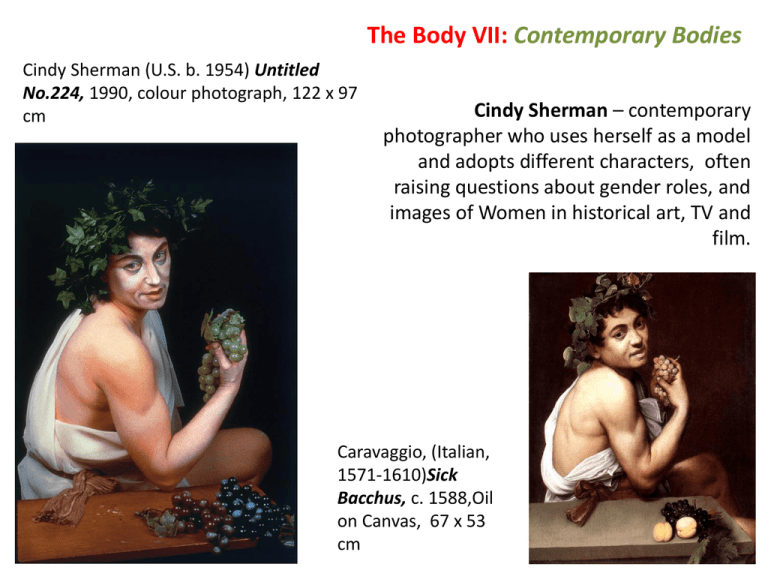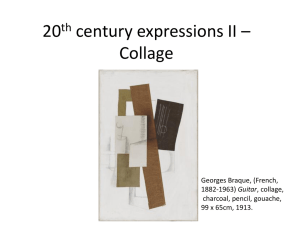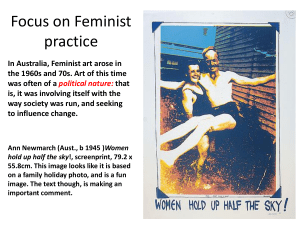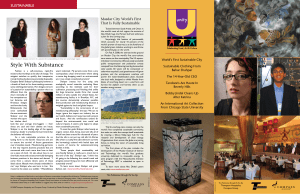THE BODY VII_ CONTEMPORARY BODIES
advertisement

The Body VII: Contemporary Bodies Cindy Sherman (U.S. b. 1954) Untitled No.224, 1990, colour photograph, 122 x 97 cm Cindy Sherman – contemporary photographer who uses herself as a model and adopts different characters, often raising questions about gender roles, and images of Women in historical art, TV and film. Caravaggio, (Italian, 1571-1610)Sick Bacchus, c. 1588,Oil on Canvas, 67 x 53 cm Postmodernism: challenging of all types of structures, traditions and beliefs. We saw the challenging of previous traditions with the avant-garde in Modernism. The new movement always thought it had the better way to get to an authentic expression. With Postmodernism, there is not that sense of ‘we have the answer’. It is more a case of ‘there ARE no definite answers. No one path is correct.’ There is no one, single truth. Rather, there are many stories; many voices. Feminist art practices, of which there are many varieties, are an example of this. Jill Orr (Aust. n.d.) Bleeding trees 1, performance, 1979 Orr uses the female body (her own) to identify with the natural environment. Her work is both Feminist and environmental. The idea of women being more connected to the earth, more in tune with it (than men) because of their reproductive cycle was a popular Feminist motif of the 1970s. The Feminist era (middle of 20th Century) also saw the rise of Goddess practices (where God, or the divine being, is seen as female rather than the more traditional idea of a Father-god.) Artist unknown, Willendorf Venus, c. 23,000 BCE, stone,10cm high. This little image, with exaggerated breasts and hips, became very popular with the rise of Feminism, and discoveries about ancient cultures who worshipped Goddesses instead of male Gods. Julie Rrap (Aust., b. 1950 ) has been involved with performance art and “body art” from the 1970s onwards. Her work involves photography, painting, sculpture, video and installations. She is interested in the psychology behind how we view photographs and video. Her work is often fun but always raises questions. She often appropriates or references historical or earlier artworks. Camouflage #3, (Elizabeth) 2000, digital photograph, 195 x 122cm Film still of Elizabeth Taylor in National Velvet, 1945 Overstepping, 2001, digital photograph, 120 x 120cm Examining the Exam… Q: Shahzia Sikander was born in 1969 in Lahore, Pakistan. She has achieved international recognition for her artistic practice. In 2007 her artwork Transformation as Narrative was exhibited at the Museum of Contemporary Art, Sydney. Explain how Shahzia Sikander uses different procedures in the production and exhibition of her artwork Transformation as Narrative. “Sikander carries a camera with her daily, documenting her observations which are frequently incorporated into her work in some shape or form…” – Rachel Kent, Curator. Plate 1: A selection of Sikander’s Preliminary drawings; photographs And reference materials. Plate 2: Gallery technicians assisting with the Preparation of Sikander’s artwork Transformation Narrative 2007 at MCA Sydney Plate 3: Shahzia Sikander working on Transformation as Narrative, 2007 at MCA Sydney. Acrylic on wall, wall dimensions 686 x 1164cm.









